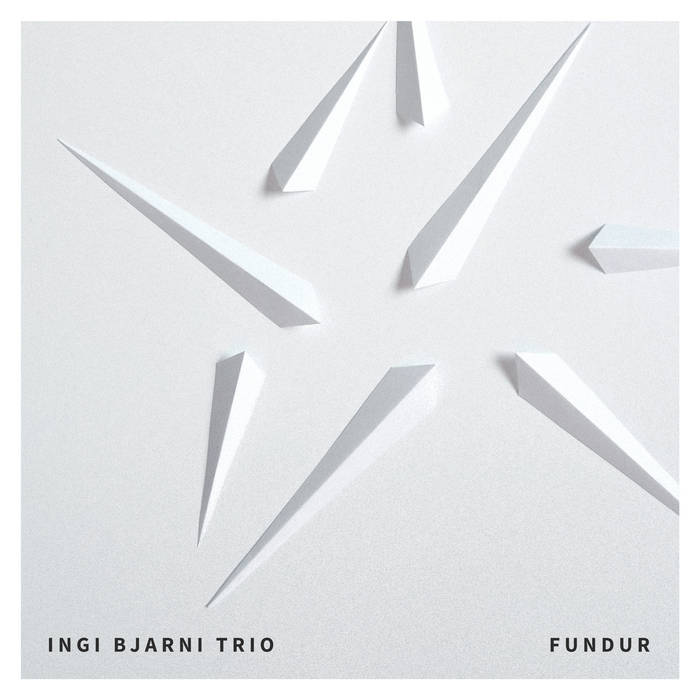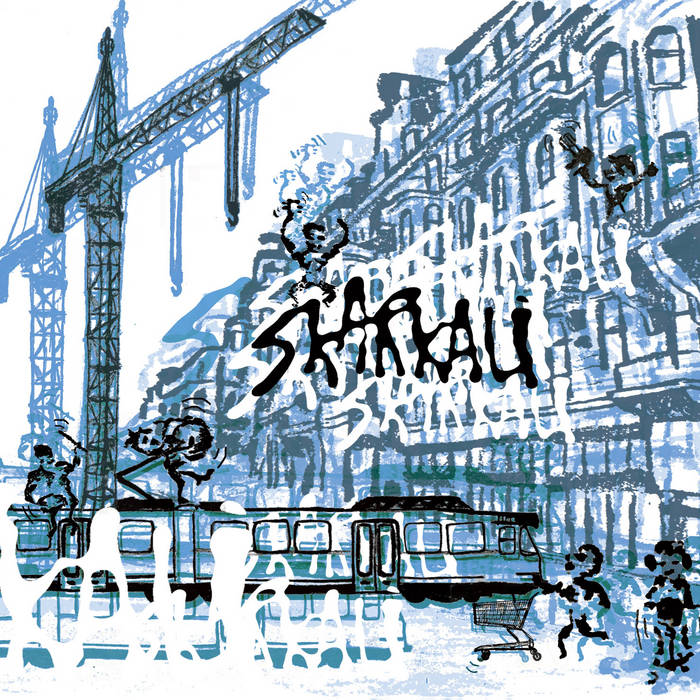Ingi Bjarni – Hope
release 17.01.2025
Ingi Bjarni Skúlason – piano and music
Anders Jormin – double bass
Hilmar Jensson – guitar
Magnús Trygvason Eliassen – drums
Label: Losen Records
ingibjarni.com
„Der isländische Künstler Ingi Bjarni ist ein improvisierender Pianist und Komponist, der bezaubernde Töne und poetische Melodien hervorbringt. Er macht seine eigene Art von Volksmusik mit der Freiheit des Ausdrucks und Raum für lyrische und freie Improvisation.“
Die Liner Notes verraten viel von der ursächlichen Grundstimmung, in der die Kompositionen entstanden sind, der Tod der sehr religiösen Mutter datiert aus dem Jahr 2021, in dem Jahr entstanden sieben der neun Stücke, eins davon schrieb er in der Kirche, das spielt insofern mit hinein, als das Momentum religiöser Erhabenheit oder der Transzendenz durchweg mit schwingt, und in allen Stücken ihre eigene Schicht transportiert: die der Verbindungen zwischen dem, was Hier und Jetzt ist und dem, was imaginär zu sein scheint: das Erinnern und sich Einlassen auf die Verstorbene, die per innerer Stimme weiterlebt, die Ernsthaftigkeit im Erinnern, sie schwingt ebenfalls mit.
So bestechend und mitreißend die Melodien und Kompositionen sind, so kräftig und intensiv sind die Steigerungsabläufe und in sich verschachtelten Themen, was gleich zum nächsten Teil der Schichtungen wird. Die klare, einfache und gekonnt gesetzte Meldodieführung hier, die in sich kohärente Erzählweise darum herum und die akzentuierte Ausführung. Ebene auf Ebene. Schicht auf Schicht. Leicht und schwer halten sich die Waage oder in Schwebe. Reales trifft auf Unterbewusstes. Echte Empfindung auf flüchtige Darstellung, zwischen Hier und Jetzt webt sich das in Bezüge zu denen, die gegangen sind und denen, die noch zu erwarten wären. Getragen wird es vom titelgebenden Hope – die Hoffnung.
Das Leben geht weiter, auch wenn es auf dem Weg dorthin Unebenheiten gibt.
Die sind spürbar im Haegur Dans – die Aufgabe schien klar: ein langsamer Tanz, dem das Schlagzeug einen treibenden Beat entgegensetzt und diesen erforschen soll, dann aber gerät alles aus den Fugen, alles spricht im freitonalen und unbestimmbaren Raum zueinander und bringt seine eigene Dynamik ins Spiel. Da nichts mal eben so oder anders erscheint, sondern immer so und anders gleichzeit ist, lässt sich behaupten, es gibt kein Einfach ohne komplementäres Komplex.
Das führt in der Konsequenz zu einer Aufnahme, die in jeder Sequenz Spannung atmet, ob nun Continuation genannt, ein Stück voller Brüche und ineinander verwickelten Aussagen, ob nun Eftir Allt, also nach all dem – es geht ohnehin von vorne los – ob nun Escaped – die Frage entsteht: wem oder was entkommen, kehrt all das nicht in Schleifen wieder?
Da ich die Aufnahme gleich noch einmal höre und weitere Entdeckungen mache.
Im Ergebnis haben wir eine konzentrierte und spannungsgeladene Aufnahme, die sich als nun siebtes Ingi Bjarni Album anschickt, zum typischen Ingi Bjarni Sound beizutragen: Musik, die in ihrer Assoziationstiefe Raum gibt, Ton für Ton eigene Räumlichkeiten entwickelt, diese Räume haben das Zeug, nicht nur die auszufüllen, die sie erzeugen, sondern in ähnlichem Umfang die, die sich auf sie einlassen – oder sich mitnehmen lassen – ob April Dreams oder Uplift – die Ausgewogenheit zwischen Komposition und Linienführung in den Solis oder die fast schon haptische Qualität, die Greifbarkeit von Melodie und Harmonie – das ist nie nur selbstbezogen vorgetragen, selbst die Explosionszeichnungen scheinen von einer inneren Kraft zusammengehalten, Desember ist kein Christmas-Song, sondern ein Lied, das im Dezember geschrieben wurde und das Ende des Jahres symbolisiert, der Song handelt davon, die Dinge zu akzeptieren, wie sie sind.
Sollte dem wirklich so sein, stellt sich die Frage: wie ist es um die Dinge bestellt.
Nun, da ist auch im Desember eine über sich hinaus weisende Melodie – sie mündet in Escaped. Was so viel wie ein geglücktes Entkommen bedeuten könnte. Warum aber entkommen wollen, wenn die Aufnahmen inspirierend erscheinen. Was auf die Alben Fragile Magic und Farfugler ebenso zutrifft. Auch das Debut Skarkali aus dem Jahr 2015 hervorzuholen, lohnt sich. Oder Tenging aus dem Jahr 2019.
Nehmen wir es wie es ist: ein hervorragender Pianist komponiert Melodien, die sich festsetzen und holt hervorragenden Schlagzeuger, Bassisten und Gitarissten mit ans Set, zusammen erzeugen sie ein stimmungsvolles Album – mit viel Hoffnung und Auftrieb:
mit den besten Empfehlungen.
Wieder an den Anfang gespult heißt es, Zitat Liner Notes:
Das Album beginnt mit dem geräumigen Titeltrack Hope, mit einem schönen Bass-Intro von Anders Jormin, in dem er die Bassmelodie des Songs andeutet. Uplift ist ebenfalls ein Song, der mit dem Thema Hoffnung verbunden ist, eine erhebende Melodie, die zwischen den Metren 11/8 und 6/4 wechselt, mit einer starken, aber subtilen, von der Volksmusik inspirierten Melodie. Das dritte Stück, der sehr lyrische Chant, beginnt mit einem improvisierten Klavierintro. Dann setzt die singbare Melodie ein. Dies ist wirklich ein Stück, das gesungen werden könnte, auch ohne Text. Singen hat eine heilende Kraft, also ist dies vielleicht ein Chant zur Heilung.
Ingi Bjarni – Hope

von Ingi Bjarni
“Icelandic artist Ingi Bjarni is an improvising pianist and composer, crafting enchanting tones and poetic melodies. He makes his own kind of folk music with the freedom of expressiveness, and space for both lyrical and free improvisation.”
The liner notes reveal a lot about the underlying mood in which the compositions were created, the death of the very religious mother dates from 2021, seven of the nine pieces were written in that year, one of which he wrote in church, which plays into the fact that the momentum of religious sublimity or transcendence resonates throughout, and transports its own layer in all the pieces: that of the connections between what is here and now and what seems to be imaginary: remembering and engaging with the deceased, who lives on via an inner voice, the seriousness in remembering, it also resonates.
As captivating and rousing as the melodies and compositions are, as powerful and intense are the progressions and interlocking themes, which immediately become the next part of the layers. The clear, simple and skillfully placed melody line here, the coherent narrative around it and the accentuated execution. Layer upon layer. Layer upon layer. Light and heavy are balanced or suspended. The real meets the subconscious. Real feeling meets fleeting representation, between here and now, weaving into references to those who have gone and those who are yet to come. It is carried by the title Hope.
Life continues even though there are bumps along the way.
These are palpable in Haegur Dans – the task seemed clear: a slow dance, which the drums counter with a driving beat and explore, but then everything gets out of joint, everything speaks to each other in a free-tonal and indeterminate space and brings its own dynamics into play. Since nothing appears one way or another, but is always one way and another at the same time, it can be said that there is no simple without a complementary complex.
As a consequence, this leads to a recording that breathes tension in every sequence, whether called Continuation, a piece full of breaks and interwoven statements, whether Eftir Allt, so after all this – it starts all over again anyway – whether Escaped – the question arises: who or what is escaping, doesn’t all this return in loops?
As I’m about to listen to the recording again and make further discoveries.
The result is a concentrated and tension-filled recording which, as the seventh Ingi Bjarni album, is preparing to contribute to the typical Ingi Bjarni sound: Music that gives space in its depth of association, developing its own spaces note by note, these spaces have what it takes to fill not only those who create them, but to a similar extent those who get involved with them – or allow themselves to be taken along – whether April Dreams or Uplift – the balance between composition and lines in the solos or the almost haptic quality, the tangibility of melody and harmony – it’s never just self-referentially performed, even the exploded diagrams seem to be held together by an inner force, Desember is not a Christmas song, but a song written in December and symbolizing the end of the year, the song is about accepting things as they are.
If this is really the case, the question arises: what is the state of things?
Well, there is also a melody in Desember that points beyond itself – it ends in Escaped. Which could mean something like a successful escape. But why want to escape when the recordings seem inspiring. Which also applies to the albums Fragile Magic and Farfugler. It’s also worth picking up the debut Skarkali from 2015. Or Tenging from 2019.
Let’s take it as it is: an outstanding pianist composes melodies that stick and brings an excellent drummer, bassist and guitarist to the set, together they create an atmospheric album – with a lot of Hope and Uplift:
with the best recommendations.
Rewind to the beginning, the liner notes say:
The album starts with the spacious title track, Hope, with a beautiful bass intro by Anders Jormin, where he hints at the bass melody of the song. Uplift is also a song connected to the theme of hope, an uplifting tune that changes between the meters of 11/8 and 6/4 with a strong, yet subtle, melody inspired by folk music. The third piece, the highly lyrical Chant, starts with an improvised piano intro. Then the singable melody starts. This is truly a piece that could be sung, even without lyrics. Singing has a healing power so perhaps this is a chant for healing.

von Ingi Bjarni Trio
2024

von Ingi Bjarni solo
2021



